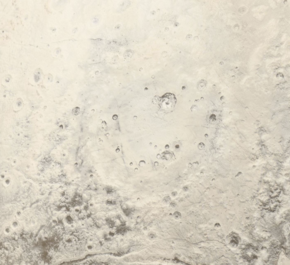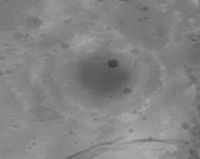Burney (crater)
 From Wikipedia - Reading time: 8 min
From Wikipedia - Reading time: 8 min
 A New Horizons of Burney basin, center. An ancient impact basin, its heavily eroded state makes it difficult to discern; its concentric rings are only slightly brighter than the surrounding plains | |
| Feature type | Multi-ring impact basin |
|---|---|
| Location | Venera Terra, Pluto |
| Coordinates | 45°41′N 133°47′E / 45.68°N 133.79°E[1] |
| Diameter | 296–350 km (184–217 mi)[1][2] |
| Depth | ~1.8–3 km (1.1–1.9 mi)[2][3]: 123 |
| Discoverer | New Horizons |
| Eponym | Venetia Burney (1918–2009) |
Burney is the second-largest known impact basin on the dwarf planet Pluto. With a diameter of over 290 kilometres (180 miles) and possibly up to 350 kilometres (220 miles), it is the second-largest known impact basin on Pluto, after the Sputnik Planitia basin. Burney is the only known impact basin on Pluto with visible multiple rims and is thus classified as a multi-ringed impact basin,[a] though its rings have been heavily eroded due to Burney's age.
Discovery and naming
[edit]As with the rest of Pluto's surface features, Burney was first seen on the New Horizons flyby of Pluto and its five moons on 14 July 2015. The impact basin was informally named Burney by the New Horizons team in honor of Venetia Burney, who suggested the name Pluto to the dwarf planet's discoverer Clyde Tombaugh in 1930.[5][6]: 10 The name was officially approved by the International Astronomical Union (IAU) on 8 August 2017.[1]
Geology
[edit]Burney is the second-largest impact feature known on Pluto, after the massive basin that encloses the glacial plains of Sputnik Planitia.[3]: 123 It is ancient, with an estimated age of at least 4 billion years old, and heavily eroded.[7][3]: 142 The structure of Burney resembles that of the Mare Orientale basin on the Moon, with a series of concentric peak rings that enclose a central depression. Burney's degraded state makes it difficult to discern its extent due to the subtle nature of its peak rings; Burney may have anywhere from 2–4 such rings. As such, estimates for Burney's diameter range from ~290 kilometres (180 miles) to ~350 kilometres (220 miles).[2][1] The peak rings of Burney are discontinuous and crenulated, standing roughly 500–1,000 metres (1,600–3,300 feet) high. The central depression of Burney is approximately 180 kilometres (110 miles) across and roughly 1.8–3 kilometres (1.1–1.9 miles) deep.[2][3]: 123 Within Burney are numerous smaller impact craters, one of which has been officially named Hardaway.[8]
Much of Burney's basin floor is glaciated. Its surface is covered in bright, coarse grains of nitrogen ice mixed with water ice.[9][10] Burney's peak rings are coated in methane ice, indicating that methane preferentially condenses on the high-altitude mountain peaks that comprise the concentric rings. By contrast, Burney's floor is poor in methane ice and much smoother than the surrounding plains, possibly from differences in erosion or from heavier glaciation.[7][3]: 127–128 Several dark streaks similar to those found in Sputnik Planitia were observed in and around Burney.[11] Models of Pluto's climate indicate that Burney likely experiences downward-flowing katabatic winds.[12]
Burney is surrounded by a broad region to the northwest of Sputnik Planitia that hosts a type of terrain informally called washboard terrain. This terrain is characterized by parallel ridges spaced 1–2 kilometres (0.62–1.24 miles) apart and covers large parts of Burney's basin floor. One hypothesis for the origin of the washboard terrain is from the collection and deposition of material from an ancient period of heavy regional glaciation. The age of the washboard terrain appears to only marginally postdate the impact event that created Burney.[7]
See also
[edit]- Mare Moscoviense basin – Lunar mare on the far side of the Moon
- Dorothy – Largest crater on Charon
Notes
[edit]- ^ Simonelli, a similarly-sized crater on the anti-encounter hemisphere of Pluto, may have multiple rings.[3]: 123 Sputnik Planitia basin, though much larger, does not have visible rings; any structural features within its outermost rim are buried beneath its nitrogen glaciers. The blocky mountains alongside Sputnik Planitia's western border may be related to a peak ring within the basin.[4]
References
[edit]- ^ a b c d "Burney". Gazetteer of Planetary Nomenclature. USGS Astrogeology Research Program. (Center Latitude: 45.68°, Center Longitude: 133.79°; Planetocentric, +East)
- ^ a b c d McKinnon, William B.; Schenk, P. M.; Mao, X.; et al. (March 2017). Impact Origin of Sputnik Planitia Basin, Pluto (PDF). 48th Lunar and Planetary Science Conference. The Woodlands, Texas, United States. 2854. Retrieved 4 May 2024.
- ^ a b c d e f Stern, S. Alan (August 2021). Moore, Jeffrey M.; Grundy, William M.; Young, Leslie A.; Binzel, Richard P. (eds.). The Pluto System After New Horizons. The University of Arizona Press. ISBN 9780816540945.
- ^ Moruzzi, Samantha A.; Andrews-Hanna, Jeffrey C.; Schenk, Paul; Johnson, Brandon C. (November 2023). "Pluto's Sputnik basin as a peak-ring or multiring basin: A comparative study". Icarus. 405. Bibcode:2023Icar..40515721M. doi:10.1016/j.icarus.2023.115721. S2CID 260217921. 115721.
- ^ Rincon, Paul (13 January 2006). "The girl who named a planet". Pluto: The Discovery of Planet X. BBC News. Archived from the original on 4 October 2018. Retrieved 12 April 2007.
- ^ Gosmeyer, C. M. (16 December 2015). "Relative and Absolute Ages of Pluto and Charon's Surfaces Using Crater Counts". Retrieved 4 May 2024.
- ^ a b c White, Oliver L.; Moore, Jeffrey M.; Howard, Alan D.; et al. (January 2019). "Washboard and fluted terrains on Pluto as evidence for ancient glaciation". Nature Astronomy. 3: 62–68. Bibcode:2019NatAs...3...62W. doi:10.1038/s41550-018-0592-z. S2CID 135139421.
- ^ "Pluto Nomenclature" (PDF). Gazetteer of Planetary Nomeclature. 22 September 2023. Retrieved 4 May 2024.
- ^ Emran, A.; Dalle Ore, C. M.; Ahrens, C. J.; Khan, M. K. H.; Chevrier, V. F.; Cruikshank, D. P. (January 2023). "Pluto's Surface Mapping Using Unsupervised Learning from Near-infrared Observations of LEISA/Ralph". The Planetary Science Journal. 4 (1): 15. arXiv:2301.06027. Bibcode:2023PSJ.....4...15E. doi:10.3847/PSJ/acb0cc. 54.
- ^ Schmitt, B.; Philippe, S.; Grundy, W. M.; et al. (May 2017). "Physical state and distribution of materials at the surface of Pluto from New Horizons LEISA imaging spectrometer". Icarus. 287: 229–260. Bibcode:2017Icar..287..229S. doi:10.1016/j.icarus.2016.12.025.
- ^ Hofgartner, J. D.; Buratti, B. J.; Devins, S. L.; et al. (March 2018). "A search for temporal changes on Pluto and Charon". Icarus. 302: 273–284. arXiv:1711.02750. Bibcode:2018Icar..302..273H. doi:10.1016/j.icarus.2017.10.044.
- ^ Forget, F.; Bertrand, T.; Vangvichith, M.; Leconte, J.; Millour, E.; Lellouch, E. (May 2017). "A post-new horizons global climate model of Pluto including the N2, CH4 and CO cycles" (PDF). Icarus. 287: 54–71. Bibcode:2017Icar..287...54F. doi:10.1016/j.icarus.2016.11.038. S2CID 125136232. Archived (PDF) from the original on 15 November 2023. Retrieved 4 May 2024.
 KSF
KSF


